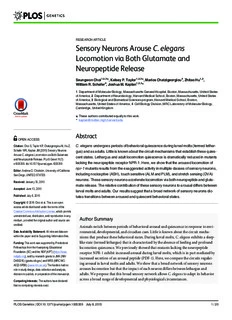
Sensory Neurons Arouse C. elegans Locomotion via Both Glutamate and Neuropeptide Release PDF
Preview Sensory Neurons Arouse C. elegans Locomotion via Both Glutamate and Neuropeptide Release
RESEARCHARTICLE Sensory Neurons Arouse . C elegans Locomotion via Both Glutamate and Neuropeptide Release SeungwonChoi1,2,3☯,KelseyP.Taylor1,2,3☯,MariosChatzigeorgiou4,ZhitaoHu1,2, WilliamR.Schafer4,JoshuaM.Kaplan1,2,3* 1 DepartmentofMolecularBiology,MassachusettsGeneralHospital,Boston,Massachusetts,UnitedStates ofAmerica,2 DepartmentofNeurobiology,HarvardMedicalSchool,Boston,Massachusetts,UnitedStates ofAmerica,3 BiologicalandBiomedicalSciencesprogram,HarvardMedicalSchool,Boston, a11111 Massachusetts,UnitedStatesofAmerica,4 CellBiologyDivision,MRCLaboratoryofMolecularBiology, Cambridge,UnitedKingdom ☯Theseauthorscontributedequallytothiswork. * [email protected] Abstract OPENACCESS Citation:ChoiS,TaylorKP,ChatzigeorgiouM,HuZ, C.elegansundergoesperiodsofbehavioralquiescenceduringlarvalmolts(termedlethar- SchaferWR,KaplanJM(2015)SensoryNeurons gus)andasadults.Littleisknownaboutthecircuitmechanismsthatestablishthesequies- ArouseC.elegansLocomotionviaBothGlutamate centstates.Lethargusandadultlocomotionquiescenceisdramaticallyreducedinmutants andNeuropeptideRelease.PLoSGenet11(7): e1005359.doi:10.1371/journal.pgen.1005359 lackingtheneuropeptidereceptorNPR-1.Here,weshowthatthearousedlocomotionof npr-1mutantsresultsfromtheexaggeratedactivityinmultipleclassesofsensoryneurons, Editor:AndrewD.Chisholm,UniversityofCalifornia SanDiego,UNITEDSTATES includingnociceptive(ASH),touchsensitive(ALMandPLM),andstretchsensing(DVA) neurons.Thesesensoryneuronsacceleratelocomotionviabothneuropeptideandgluta- Received:January30,2015 materelease.Therelativecontributionofthesesensoryneuronstoarousaldiffersbetween Accepted:June13,2015 larvalmoltsandadults.Ourresultssuggestthatabroadnetworkofsensoryneuronsdic- Published:July8,2015 tatestransitionsbetweenarousedandquiescentbehavioralstates. Copyright:©2015Choietal.Thisisanopen accessarticledistributedunderthetermsofthe CreativeCommonsAttributionLicense,whichpermits unrestricteduse,distribution,andreproductioninany AuthorSummary medium,providedtheoriginalauthorandsourceare credited. Animalsswitchbetweenperiodsofbehavioralarousalandquiescenceinresponsetoenvi- DataAvailabilityStatement:Allrelevantdataare ronmental,developmental,andcircadiancues.Littleisknownaboutthecircuitmecha- withinthepaperanditsSupportingInformationfiles. nismsthatproducethesebehavioralstates.Duringlarvalmolts,C.elegansexhibitsasleep- Funding:ThisworkwassupportedbyPredoctoral likestate(termedlethargus)thatischaracterizedbytheabsenceoffeedingandprofound FellowshipsfromtheKwanjeongEducational locomotionquiescence.Wepreviouslyshowedthatmutantslackingtheneuropeptide Foundation(SC)andtheNSF(KPT)(https://www. receptorNPR-1exhibitincreasedarousalduringlarvalmolts,whichisinpartmediatedby nsfgrfp.org),andbyresearchgrantstoJMK(NIH increasedsecretionofanarousalpeptide(PDF-1).Here,wecomparethecircuitsregulat- DK80215)(grants.nih.gov)andWRS(MRCMC- ingarousalinlarvalmoltsandadults.Weshowthatabroadnetworkofsensoryneurons A022-5PB9).(www.mrc.ac.uk).Thefundershadno arouseslocomotionbutthattheimpactofeachneurondiffersbetweenlethargusand roleinstudydesign,datacollectionandanalysis, decisiontopublish,orpreparationofthemanuscript. adults.WeproposethatthisbroadsensorynetworkallowsC.eleganstoadaptitsbehavior acrossabroadrangeofdevelopmentalandphysiologicalcircumstances. CompetingInterests:Theauthorshavedeclared thatnocompetinginterestsexist. PLOSGenetics|DOI:10.1371/journal.pgen.1005359 July8,2015 1/20 GlutamateandNeuropeptidesArouseC.elegansLocomotion Introduction Animalsundergoperiodsofbehavioralquiescenceandarousalinresponsetochangesintheir environmentandmetabolicstate.Arousalisdefinedasastateofheightenedresponsivenessto externalstimulicoupledwithincreasedmotoractivitywhereasquiescenceisassociatedwith diminishedresponsivenessandmotoractivity[1].Quiescenceandarousalcanpersistformin- utestohours.Arousalisassociatedwithfear,stress,hunger,andexposuretosexualpartners [1],whilequiescenceisassociatedwithsleepandsatiety[2].Relativelylittleisknownaboutthe specificcircuitmechanismsleadingtoarousalorquiescence.Inparticular,itisunclearifsimi- larmechanismsmediatequiescenceandarousalinresponsetodifferentcues,oratdifferent timesduringdevelopment.Toaddressthisquestion,wehaveanalyzedarousalandquiescence ofC.eleganslocomotion. Duringeachlarvalmolt,C.elegansundergoesaprolongedperiodofprofoundbehavioral quiescence,termedlethargusbehavior,wherebylocomotionandfeedingbehaviorsareinac- tiveforapproximately2hours[3].Lethargushaspropertiesofasleep-likestatesuchas reducedsensoryresponsivenessandhomeostaticreboundofquiescencefollowingperturba- tion[4].Severalgenesandmolecularpathwaysinvolvedinlethargusbehaviorhavebeen identified[4–11].Multiplesensoryresponsesarediminishedduringlethargus,including thosemediatedbyanociceptiveneuron(ASH)[12],andbymechanosensoryneurons [11,13]. MutantslackingNPR-1NeuropeptideY(NPY)receptorshavebeenutilizedasamodelfor generalizedarousal.NPR-1inhibitstheactivityofacentralsensorycircuitthatisdefinedby gapjunctionstotheRMGinterneuron[14].Innpr-1mutants,responsesmediatedbythe RMGcircuit(e.g.pheromoneandoxygenavoidance)areexaggerated,andthisheightened acuityisassociatedwithexaggeratedlocomotion(bothduringlethargusandinadults) [11,14–16].Mutationsthatincrease(e.g.npr-1)anddecrease(e.g.tax-4CNGandosm-9 TRPV)RMGcircuitactivityareassociatedwithlocomotionarousalandquiescencerespec- tively[11,14,17,18]. Wepreviouslyshowedthatlocomotionquiescenceduringlethargusisdramatically reducedinnpr-1mutantsandthatthiseffectrequiresincreasedRMGsensoryactivity[11]. Subsequentstudiesshowedthatinmicrofluidicchambersnpr-1mutantshavemodestdefects inlethargusquiescencewhensensorycuesareminimizedbutthatdramaticquiescencedefects areobservedfollowingbriefstimulationwithlightorvibration[19,20].Takentogether,these paperssuggestthatnpr-1mutantsexhibitarousedlocomotionasaconsequenceofenhanced sensoryactivity. ThearousingeffectsoftheRMGcircuitaremediatedinpartbysecretionofaneuropeptide, pigmentdispersingfactor(PDF-1)[11].ActivationofPDFreceptors(PDFR-1)inperipheral mechanosensoryneuronsenhancessensitivitytovibration,therebyacceleratinglocomotion. Thus,sensoryevokedactivityintheRMGcircuitarouseslocomotionduringlethargusthrough changesinPDF-1andPDFR-1signaling.Theseresultsraiseseveralinterestingquestions. Whichspecificsensoryneuronsareresponsibleforarousal?DoestheRMGcircuitregulate arousalviamultipleoutputs(i.e.inadditiontoPDF-1)?DoestheRMGcircuitfunctionsimi- larlyduringlethargusandinadults?Isdiminishedsensoryacuityduringlethargusrequiredfor behavioralquiescence? Hereweshowthatglutamatergictransmissionpromotesarousal,weidentifyglutamatergic neuronsandglutamatereceptorsthatmediatearousal,andweshowthatarousaloccursbydis- tinctmechanismsinlethargusandadultanimals. PLOSGenetics|DOI:10.1371/journal.pgen.1005359 July8,2015 2/20 GlutamateandNeuropeptidesArouseC.elegansLocomotion Results CholinergictransmissionatNMJsisincreasedinnpr-1adults Adultnpr-1mutantsexhibitacceleratedlocomotion(Fig1A–1C),asshowninpriorstudies [21].Fasteradultlocomotionsuggeststhatlocomotioncircuitactivityhasbeenaltered.Consis- tentwiththisidea,npr-1mutantadultshaveenhancedsensitivitytotheparalyticeffectsofa cholinesteraseinhibitor(aldicarb)(Fig1D–1FandS2AFig)[22],indicatingincreasedexcit- atorytransmissionatneuromuscularjunctions(NMJs).Tomoredirectlyassesschangesin synaptictransmission,werecordedminiatureexcitatorypost-synapticcurrents(mEPSCs)in bodymuscles,whichareevokedbyacetylcholine(ACh)releaseatNMJs.ThemEPSCrate observedinnpr-1adultswassignificantlyhigherthaninwildtypecontrolswhilemEPSC amplitudeswereunaltered(Fig1G–1I).FastermEPSCratessuggestthatAChreleasefrom motorneuronswasincreasedwhereasunalteredmEPSCamplitudesimplythatmusclerespon- sivenesstosecretedAChwasunaffected.Bycontrast,neitherAChreleaseevokedbydepolariz- ingmotorneuronswithastimulatingelectrode(evokedEPSCs),nortransmissionat GABAergicNMJs(assessedbyminiatureinhibitorypost-synapticcurrents,mIPSCs)was alteredinnpr-1mutants(S1Fig).Thisconstellationofelectrophysiologicaldefectssuggests thattonicAChrelease(assessedbymEPSCrate)wasenhancedinnpr-1mutants,whereas otherformsofneurotransmitterrelease(evokedAChreleaseandtonicGABArelease)were unaffected.EnhancedtonicAChreleaseatNMJscouldaccountfortheacceleratedlocomotion rateobservedinnpr-1adults. Enhancedcholinergictransmissioninnpr-1adultsiscausedby increasedsensoryactivity Priorstudiesshowedthatseveralbehavioralphenotypesexhibitedbynpr-1mutantsarecaused byenhancedsensitivitytoenvironmentalcues.Inparticular,sensoryresponsesmediatedby theRMGcircuitareenhancedinnpr-1mutants[14,17,18]andthisenhancedsensoryacuityis requiredforacceleratedlocomotionratesduringlethargus[11,20].Wedidseveralexperiments todetermineifenhancedRMGcircuitactivityisalsorequiredforincreasedcholinergictrans- missioninnpr-1adults.Atransgenerestoringnpr-1expressionintheRMGcircuit(usingthe flp-21promoter)rescuedtheacceleratedlocomotion(Fig1B),enhancedaldicarbsensitivity (Fig1DandS2AFig),andfastermEPSCrate(Fig1G–1I)defectsofnpr-1adults.Bycontrast, annpr-1transgeneexpressedinGABAergicneuronslackedrescuingactivity(Fig1D–1H). TheseresultsindicatethatNPR-1actsintheRMGcircuittoslowadultlocomotion.Similarly, mutationsinactivatingionchannelsrequiredforsensorytransduction(TAX-4/CNGand OCR-2/TRPV)intheRMGcircuitsuppressedthenpr-1adultlocomotion(Fig1C),aldicarb sensitivity(Fig1Eand1FandS2BandS2CFig),andmEPSCrate(Fig1Jand1K)defects.Col- lectively,theseresultssuggestthattheacceleratedadultlocomotionexhibitedbynpr-1mutants iscausedbyheightenedactivityintheRMGsensorycircuitand,consequently,correspondsto anarousedstate. InactivatingPDFsignalingdoesnotpreventarousedlocomotioninnpr-1 adults Wepreviouslyshowedthatthelethargusquiescencedefectsexhibitedbynpr-1mutantsare causedbyincreasedsecretionofPigmentdispersingfactor(PDF-1)bycellsintheRMGcircuit [11].BecausePDF-1secretionisalsoincreasedinnpr-1adults[11],wetestedtheideathatthe hyperactiveadultlocomotionofnpr-1mutantsisalsocausedbyincreasedPDFsignaling.Con- trarytothisidea,wefoundthatpdf-1andpdfr-1(PDFReceptor-1)mutationsreducedbutdid PLOSGenetics|DOI:10.1371/journal.pgen.1005359 July8,2015 3/20 GlutamateandNeuropeptidesArouseC.elegansLocomotion Fig1.CholinergictransmissionatNMJsisenhancedbyincreasedsensoryactivityinnpr-1adults.Locomotionbehaviorofsingleadultwormswas analyzedfortheindicatedgenotypes.Instantaneouslocomotionvelocity(A)andaveragelocomotionvelocity(B-C)areplotted.(A-C)Thenpr-1adult locomotiondefectwasrescuedbytransgenesexpressingNPR-1intheRMGcircuit(RMGrescue,flp-21promoter),andsuppressedindoublemutants lackingTAX-4/CNGchannels.(D-F)Thepercentageofanimalsparalyzedon1mMaldicarbat80minwereplottedfortheindicatedgenotypes.Thenumber PLOSGenetics|DOI:10.1371/journal.pgen.1005359 July8,2015 4/20 GlutamateandNeuropeptidesArouseC.elegansLocomotion oftrialsisindicatedforeachgenotype.Fulltimecoursesofaldicarb-inducedparalysisareshowninS2A–S2CFig.(D)Thenpr-1aldicarbhypersensitivity wasrescuedbytransgenesexpressingNPR-1intheRMGcircuit(RMGrescue,flp-21promoter)butnotbythoseexpressedinGABAergicneurons(GABA rescue,unc-25andunc-30promoters).(E-F)Thenpr-1aldicarbhypersensitivitywasblockedbymutationsinactivatingTAX-4/CNGchannelsorOCR-2/ TRPVchannels.(G-L)mEPSCswererecordedfrombodywallmusclesofadultwormsfortheindicatedgenotypes.RepresentativetracesofmEPSCs(G andJ)andsummarydataareshown(H,I,K,andL).(G-I)Thenpr-1cholinergictransmissiondefectwasrescuedbytransgenesexpressingNPR-1inthe RMGcircuit(RMGrescue,flp-21promoter)butnotbythoseexpressedinGABAergicneurons(GABArescue,unc-30promoter).(J-L)Thenpr-1cholinergic transmissiondefectwasabolishedbymutationsinactivatingTAX-4orOCR-2.Thenumberofanimalsanalyzedisindicatedforeachgenotype.Errorbars indicateSEM.Valuesthatdiffersignificantlyareindicated(*,p<0.05;**,p<0.01;***,p<0.001;ns,notsignificant). doi:10.1371/journal.pgen.1005359.g001 noteliminatethealdicarbhypersensitivity(Fig2Aand2BandS2DandS2EFig),theacceler- atedlocomotion(Fig2C),andincreasedmEPSCrate(Fig2Dand2E)defectsofnpr-1adults. Collectively,theseresultssuggestthatadditionalexcitatoryoutputsfromtheRMGcircuit(i.e. beyondPDF-1)mustcontributetothearousedlocomotionofnpr-1adults. Glutamatereleasedbysensoryneuronsisrequiredfornpr-1locomotion andEPSCdefects ManyC.eleganssensoryneuronsareglutamatergic,includingtwoneuronsintheRMGcircuit (ASHandASK)andthebodytouchneurons[23].Todetermineifglutamatereleasebysensory Fig2.InactivatingPDFsignalingdoesnotpreventarousedlocomotioninnpr-1adults.(A-B)Thenpr-1aldicarbhypersensitivitywasdecreasedbut notabolishedbymutationsinactivatingPDF-1orPDFR-1.Thepercentageofanimalsparalyzedon1mMaldicarbat80minwereplottedfortheindicated genotypes.Thenumberoftrialsisindicatedforeachgenotype.Fulltimecoursesofaldicarb-inducedparalysisareshowninS2DandS2EFig.(C) Locomotionbehaviorofsingleadultwormswasanalyzedfortheindicatedgenotypes.Thenpr-1adultlocomotiondefectwasnotblockedbymutations inactivatingPDF-1orPDFR-1.(D-F)mEPSCswererecordedfrombodywallmusclesofadultwormsfortheindicatedgenotypes.Representativetracesof mEPSCs(D)andsummarydataareshown(E-F).Thenpr-1cholinergictransmissiondefectwasnotsuppressedbymutationsinactivatingPDFR-1.The numberofanimalsanalyzedisindicatedforeachgenotype.ErrorbarsindicateSEM.Valuesthatdiffersignificantlyareindicated(*,p<0.05;**,p<0.01;***, p<0.001;ns,notsignificant). doi:10.1371/journal.pgen.1005359.g002 PLOSGenetics|DOI:10.1371/journal.pgen.1005359 July8,2015 5/20 GlutamateandNeuropeptidesArouseC.elegansLocomotion neuronsisrequiredforacceleratedlocomotioninnpr-1mutants,weanalyzedmutationsthat inactivatethevesicularglutamatetransporter(eat-4VGLUT),whichisprimarilyexpressedin sensoryneurons[23].eat-4VGLUTmutationsblockedtheincreasedmotilefractionandloco- motionspeedofnpr-1mutantsbothduringtheL4-Adult(L4/A)molt(Fig3A–3C)andin adults(Fig3Dand3E).eat-4mutationsalsoblockedthehypersensitivitytoaldicarb(Fig3F Fig3.Glutamatereleasedbysensoryneuronsisrequiredforthenpr-1locomotionandthecholinergictransmissiondefects.Locomotionbehavior ofsinglewormsduringtheL4/Alethargus(A-C)andinadults(D-E)wasanalyzedintheindicatedgenotypes.Instantaneouslocomotionvelocity(A,D), averagemotilefraction(B),andaveragelocomotionvelocity(C,E)areplotted.Thenpr-1locomotiondefectwassuppressedbymutationsinactivatingEAT- 4/VGLUT,andpartiallyreinstatedbytransgenesexpressingEAT-4inASHneurons(sra-6promoter)andtouchneurons(mec-4promoter)ineat-4;npr-1 doublemutantsusingtheindicatedpromoters.AnEAT-4transgeneexpressedinASKneurons(sra-9promoter)lackedrescuingactivity.(F)Thenpr-1 aldicarbhypersensitivitywassuppressedbymutationsinactivatingEAT-4/VGLUT.Thepercentageofanimalsparalyzedon1mMaldicarbat80minwere plottedfortheindicatedgenotypes.Thenumberoftrialsisindicatedforeachgenotype.Fulltimecoursesofaldicarb-inucedparalysisareshowninS2FFig. (G-I)Thenpr-1cholinergictransmissiondefectwasabolishedbymutationsinactivatingEAT-4/VGLUT.mEPSCswererecordedfrombodywallmusclesof adultwormsfortheindicatedgenotypes.RepresentativetracesofmEPSCs(G)andsummarydataareshown(H-I).Thenumberofanimalsanalyzedis indicatedforeachgenotype.ErrorbarsindicateSEM.Valuesthatdiffersignificantlyareindicated(*,p<0.05;**,p<0.01;***,p<0.001;ns,notsignificant). doi:10.1371/journal.pgen.1005359.g003 PLOSGenetics|DOI:10.1371/journal.pgen.1005359 July8,2015 6/20 GlutamateandNeuropeptidesArouseC.elegansLocomotion andS2FFig)andincreasedmEPSCrate(Fig3Gand3H)defectsofnpr-1adults.Transgenes restoringEAT-4expressionintouchneuronsandASHneuronspartiallyreinstatedboth lethargus(Fig3Band3C)andadultlocomotion(Fig3Dand3E)defectsineat-4;npr-1double mutants,whereastransgenesexpressedinASKlackedrescuingactivity(Fig3Band3C).eat-4 transgeneshadnoeffectonlethargusquiescenceinwildtypeanimals(S3Fig).Theseresults suggestthatglutamatereleasedbyASHandtouchneuronsarouseslocomotioninL4/Aand adultnpr-1mutants. ASHactivityisassociatedwithlocomotionarousal TheprecedingresultssuggestthatASHsynapticoutputarouseslocomotioninnpr-1mutants. Wedidseveraladditionalexperimentstotestthisidea.IfalteredASHoutputwererequiredfor arousedlocomotion,wewouldexpectthatnpr-1mutantslackingASHneuronswouldhave increasedlocomotionquiescence.Totestthisidea,weinducedASHcelldeathwithatransgene thatexpressesthepro-apoptoticcaspaseCED-3.KillingASHsignificantlydecreasedtheL4/A motilefractionandlocomotionrateinnpr-1mutants(Fig4A–4C).Bycontrast,ASHablation hadlittleeffectonthelocomotionrateofnpr-1adults(Fig4D). TodetermineifASHactivityisincreasedinnpr-1mutantsduringlethargus,weexamined sensory-evokedcalciumresponsesinASH,usingthegeneticallyencodedcalciumindicator Cameleon.ASHmediatesavoidanceresponsestocopperandhyper-osmoticstimuli.Consis- tentwitharecentstudy[12],themagnitudeofcopper(Fig4Eand4F)andglycerol-evoked (S4AandS4BFig)calciumtransientsinASHwassignificantlydecreasedduringlethargusin wild-typeanimals.DecreasedASHresponsivenesstocopperandglycerolduringL4/Alethar- guswasblockedinnpr-1mutants,whereasASHresponsivenessinadultswasunalteredinnpr- 1mutants(Fig4Eand4FandS4AandS4BFig).TransgenesexpressingNPR-1intheRMGcir- cuit(usingtheflp-21promoter)orinASH(usingthesra-6promoter)reinstatedtheL4/A decreaseincopperandglycerol-evokedASHcalciumtransientsinnpr-1mutants(Fig4Gand 4HandS4CandS4DFig).TheseresultssuggestthatNPR-1actsinASHtoinhibitsensory responsesandthatincreasedASHactivityisrequiredforacceleratedlocomotionofnpr-1 mutantsduringlethargusbutnotinadults. TodetermineifincreasedASHactivityissufficienttoarouselocomotion,weanalyzedloco- motionafterartificiallydepolarizingASHneurons.Forthisexperiment,weutilizedtransgenic animalsthatexpressratTRPV1capsaicinreceptorsinASHneurons[24].Intheseanimals, capsaicintreatmentevokesASH-mediatedavoidancebehaviors[24].A5-hourcapsaicintreat- menthadlittleeffectonL4/Amotilefractionandlocomotionvelocity[11],whereascapsaicin treatmentsignificantlyacceleratedadultlocomotionandincreasedaldicarbsensitivity(Figs 4I–5JandS2GFig).TheseeffectswerenotobservedinanimalslackingTRPV1expressionin ASHneurons(Fig4Iand4J).Thus,forcedASHdepolarizationwassufficienttoarouseadult butnotletharguslocomotion.Collectively,theseresultssuggestthatdiminishedandheight- enedASHactivityisassociatedwithlocomotionquiescenceandarousalrespectively;however, themagnitudeofASH’sarousingeffectsdifferbetweenlethargusandadultanimals. GLR-2AMPAreceptorsarerequiredforthenpr-1lethargusdefect Whichglutamatereceptorsarouselocomotioninnpr-1mutants?Glutamate-activatedcation channels,AMPA(GLR-1and-2)andNMDA(NMR-1and-2)receptors,mediateexcitatory transmissionatASH-interneuron[25–27].Thenpr-1L4/Aquiescencedefectwasabolishedin glr-2;npr-1doublemutants(Fig5A–5C),whileglr-1mutationshadnoeffect(Fig5Dand5E). Bycontrast,glr-1,glr-2,andnmr-1mutationshadlittleeffectonnpr-1adultlocomotion(Fig 5FandS5Fig).Similarly,glr-2mutationsdidnotblocktheincreasedmEPSCrateinnpr-1 PLOSGenetics|DOI:10.1371/journal.pgen.1005359 July8,2015 7/20 GlutamateandNeuropeptidesArouseC.elegansLocomotion Fig4.ASHactivityisassociatedwithlocomotionarousal.LocomotionbehaviorduringtheL4/Alethargus(A-C)andinadults(D)ofsinglewormswhose ASHneuronswereablatedbytransgenicoverexpressionofCED-3inASHneurons(sra-6promoter)wasanalyzedintheindicatedgenotypes.Animalswere analyzedbyfluorescencemicroscopyafterlocomotionrecordingstodetermineifASHneuronswereablated(1–2ASH:animalswith1or2ASHintact neurons;0ASH:animalslackingviableASHneurons).Instantaneouslocomotionvelocity(A),averagemotilefraction(B),andaveragelocomotionvelocity (C-D)areplotted.Thenpr-1locomotiondefectduringtheL4/Alethargus,butnotinadults,waspartiallysuppressedinthetransgenicanimalsinwhichbothof ASHneuronswereablated(0ASH).(E-H)Copper-evokedcalciumtransientsinASHwereanalyzedinL4,L4/A,andadultsoftheindicatedgenotypesusing cameleonasacalciumindicator.Averagedresponses(E,G),andtheamplitudesofindividualtrials(F,H)areshownforeachgenotype.Eachtrace representstheaveragepercentagechangeinYFP/CFPfluorescenceratio.Thelighttanrectangleindicatesthedurationforwhich10mMcopperwas PLOSGenetics|DOI:10.1371/journal.pgen.1005359 July8,2015 8/20 GlutamateandNeuropeptidesArouseC.elegansLocomotion applied.DarkgrayshadingofeachtraceindicatesSEMofthemeanresponse.(E-F)Copper-evokedcalciumtransientsinASHneuronsweresignificantly reducedduringL4/Alethargus,andthiseffectwasabolishedinnpr-1mutants.(G-H)ThisdefectduringL4/Aletharguswasrescuedbytransgenes expressingNPR-1intheRMGcircuit(RMGrescue,flp-21promoter)orinASHneurons(ASHrescue,sra-6promoter).(I-J)ForceddepolarizationofASH neuronsincreasedadultlocomotionvelocity(I)andaldicarbsensitivity(J).RatTRPV1wasectopicallyexpressedinASHneurons(usingthesra-6promoter). (I)Locomotionbehaviorofadulttransgenicwormswasanalyzedwithorwithoutcapsaicintreatment(5hours).Averagelocomotionvelocity(I)isplotted. CapsaicintreatmentincreasedadultlocomotionvelocityintransgenicanimalsexpressingTRPV1inASHneurons,butnotinwildtypecontrols.Thenumber ofanimalsanalyzedisindicatedforeachgenotype.(J)Thepercentageofanimalsparalyzedon1mMaldicarbat80minwithorwithoutcapsaicintreatment (2–3hourspretreatment)wereplottedfortheindicatedgenotypes.Thenumberoftrialsisindicatedforeachgenotype.Fulltimecoursesforaldicarb-induced paralysisareshowninS2GFig.CapsaicintreatmentincreasedaldicarbsensitivityintransgenicanimalsexpressingTRPV1inASHneurons,butnotinwild typecontrols.ErrorbarsindicateSEM.Valuesthatdiffersignificantlyareindicated(***,p<0.001;ns,notsignificant). doi:10.1371/journal.pgen.1005359.g004 adults(Fig5G).TheseresultssuggestthatGLR-2AMPAreceptorsarespecificallyrequiredfor thearousedlocomotionduringtheL4/Alethargusinnpr-1mutants. GLR-2AMPAreceptorsactinAIAandDVAtomediatearousal WhichsynaptictargetsofASHandtouchneuronsmediatelocomotionarousal?Toaddress thisquestion,weidentifiedtheneuronsinwhichGLR-2functionisrequired.ArousedL4/A locomotionrequiresGLR-2butnotGLR-1receptors;consequently,wereasonedthattherele- vantneuronsarelikelytoexpressGLR-2butnotGLR-1.GLR-1andGLR-2areco-expressed inmanyneurons;however,afewGLR-2-expressingneuronslackGLR-1,includingDVA(a stretch-activatedneuron)andAIA(aninterneuronintheheadganglia)[25–27].TheL4/A quiescencedefectwaspartiallyrestoredinglr-2;npr-1doublemutantsbytransgenesexpressing GLR-2inDVAandAIAneurons,whereastransgenesexpressedintheventralcordinterneu- rons(usingtheglr-1promoter)failedtorescue(Fig5Band5C).Transgenicexpressionof GLR-2inDVAorAIAhadnoeffectonlethargusquiescenceinwildtypeworms(S3Sig). TheseresultssuggestthatGLR-2AMPAreceptorsexpressedinAIAandDVAneuronsarouse L4/Alocomotioninnpr-1mutants.DVAreceivesdirectsynapticinputfromthetouchneuron PLMwhileAIAreceivesdirectinputfromASH[28].Thus,increasedtransmissionat ASH-AIAandPLM-DVAsynapsescouldaccountforGLR-2’seffectsonlocomotionrate. Becauseweonlyobservedpartialrescuebyglr-2transgenesexpressedinAIAandDVA,itis likelytheGLR-2functionisrequiredinadditional(asyetunidentified)neurons. HowdoAIAandDVAarouselocomotion?AIAneuronsprovidesynapticinputtoASK andASI,bothofwhichexpressPDF-1[11,29].Thus,heightenedAIAactivitycouldarouse locomotionbyenhancingPDF-1secretion.ToassessthelevelofPDF-1secretion,weanalyzed PDF-1::YFPfluorescenceintheendolysosomalcompartmentofcoelomocytes,whicharespe- cializedscavengercellsthatinternalizeproteinssecretedintothebodycavity[30,31].Inactivat- ingGLR-2didnotalterPDF-1::YFPfluorescenceincoelomocytesinbothadultandL4/A animals(Fig6).TheseresultssuggestthatthearousingeffectsofGLR-2arenotmediatedby changesinPDFsecretion.DVAneuronsreceivedirectsynapticinputfromthePLMtouch neurons[32],andsecreteNLP-12(aneuropeptidethataccelerateslocomotion)[33].Thus, increasedDVAactivitycouldcontributetolocomotionarousalinnpr-1mutants.Threeresults supportthisidea.First,PLMneuronsexhibitenhancedtouch-evokedcalciumresponsesin adultnpr-1mutants(S6Fig).Thus,PLMneuronshaveincreasedsensoryacuityinnpr-1 mutants,similartotheeffectwepreviouslyshowedforALMneurons[11].Second,inducing DVAcelldeath(withaCED-3transgene)significantlyreducednpr-1locomotionrateduring L4/Alethargus(Fig5H–5J),butnotinadults(Fig5K).Third,DVAsecretionofNLP-12issig- nificantlyincreasedinnpr-1mutants[33],indicatingincreasedDVAactivity.Theseresults suggestthatPLMneuronsprovideenhancedexcitatoryinputtoDVAinnpr-1mutants,which promotesarousedL4/Alocomotion. PLOSGenetics|DOI:10.1371/journal.pgen.1005359 July8,2015 9/20 GlutamateandNeuropeptidesArouseC.elegansLocomotion Fig5.GLR-2AMPAreceptorsarerequiredforthenpr-1lethargusdefect.LocomotionbehaviorofsinglewormsduringtheL4/Alethargus(A-EandH-J) andinadults(F,K)wasanalyzedintheindicatedgenotypes.Instantaneouslocomotionvelocity(A,H),averagemotilefraction(B,D,andI),andaverage locomotionvelocity(C,E,F,JandK)areplotted.(A-C)Thenpr-1locomotiondefectduringL4/Aletharguswassuppressedbymutationsinactivatingglr-2 AMPAreceptors,andpartiallyreinstatedbytransgenesexpressingGLR-2inAIA(gcy-28(d)promoter)andDVA(nlp-12promoter)neurons,butnotinVentral CordInterneurons(V.C.I.,glr-1promoter)inglr-2;npr-1doublemutantsusingtheindicatedpromoters.(D-E)glr-1mutationshadnosuppressingeffect.(F) glr-2mutationsdidnotblocktheincreasedlocomotioninnpr-1adults.(G)mEPSCswererecordedfrombodywallmusclesoftheadultwormsforthe indicatedgenotypes.Summarydataareshown.(G)glr-2mutationsdidnotblocktheincreasedmEPSCrateinnpr-1adults.(H-K)Locomotionbehavior duringtheL4/Alethargus(H-J)andinadults(K)ofsinglewormswhoseDVAneuronisablatedbytransgenicoverexpressionofCED-3inDVAneuron(nlp- 12promoter)wasanalyzedintheindicatedgenotypes.AnimalswereanalyzedbyfluorescencemicroscopyafterlocomotionrecordingstodetermineifDVA wasablated.Thenpr-1locomotiondefectduringtheL4/Alethargus,butnotinadults,waspartiallysuppressedinthetransgenicanimalsinwhichDVA wasablated(-DVA).Thenumberofanimalsanalyzedisindicatedforeachgenotype.ErrorbarsindicateSEM.Valuesthatdiffersignificantlyareindicated (**,p<0.01;***,p<0.001;ns,notsignificant). doi:10.1371/journal.pgen.1005359.g005 Discussion Toinvestigatethecircuitmechanismsforarousal,weanalyzedthelocomotionofnpr-1mutants inawake(adult)andquiescent(lethargus)states.Ourresultsleadtofiveconclusions.First,mul- tipleclassesofsensoryneuronscontributetoarousal.Second,diminishedsensoryacuityisa PLOSGenetics|DOI:10.1371/journal.pgen.1005359 July8,2015 10/20
Description: